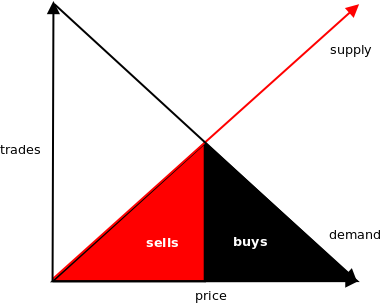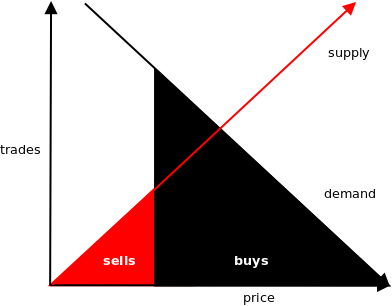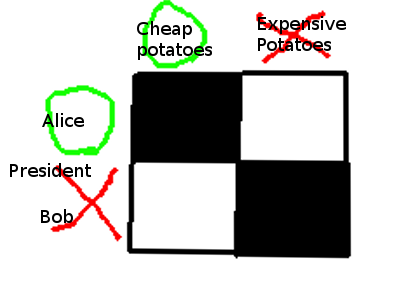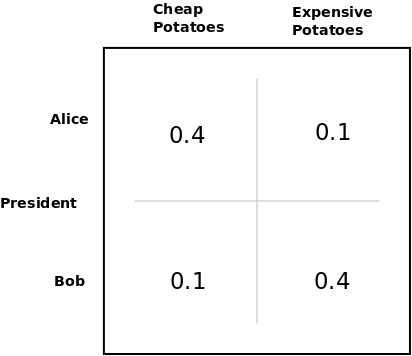Æternity blockchain The trustless, decentralized and purely functional oracle machine




Abstract— Since the introduction of Ethereum in 2014 there has been great interest in decentralized trustless applications(smart contracts). Consequently, many have tried to implement applications with real world data on top of a blockchain. We believe that storing the application’s state and code on-chain is wrong for several reasons.
We present a highly scalable blockchain architecture with a consensus mechanism which is also used to check the oracle. This makes the oracle very efficient, because it avoids layering one consensus mechanism on top of another. State channels are integrated to increase privacy and scalability. Tokens in channels can be transferred using purely functional smart contracts that can access oracle answers. By not storing contract code or state on-chain, we are able to make smart contracts easier to analyze and faster to process, with no substantial loss in de facto functionality.
Applications like markets for synthetic assets and prediction markets can be efficiently implemented at global scale. Several parts have proof-of-concept implementations in Erlang. Development tools and application essentials such as a wallet, naming and identity system will also be provided.
I. INTRODUCTION
The intention of this paper is to give a overview of the ?ternity blockchain architecture and possible applications.
More detailed papers will be released in the future, specifically for the consensus and governance mechanisms. However, it should be noted that our architecture is holistic; all components tie together and synergize, in a modular way.
The rest of this paper is broken into four parts. First, we will introduce and discuss the fundamental theoretical ideas that inform our architecture. Second, we will discuss the included essential applications, other possible use cases and give intuitions for how to use the platform as a developer. Third, we will present the current proof-of-concept implementation,
written in Erlang. We conclude with a discussion, including possible future directions and comparisons to other technologies.
A. Previous Work
Blockchains, first of all Bitcoin, have shown a new way to architect value exchange on the Internet [1]. This has been followed by a number of promising advances: Ethereum demonstrated a way to write Turing-complete smart contracts secured by a blockchain architecture [2]; Truthcoin created tools for making oracles on blockchains [3], while GroupGnosis and Augur showed how to make them more efficient [4]; Casey Detrio showed how to make markets on blockchains [5]; Namecoin showed how to make the distributed equivalent of a domain name server [6]; Factom showed how a blockchain that stores hashes can be used as a proof of existence for any digital data [7].
These technologies show great promise when it comes to providing first-class financial and legal services to anyone. So far however, they have failed to come together to a unified whole that actually fulfills the promise. Specifically, all solutions so far have been lacking in at least one of the following respects: governance, scalability, scripting safety and cheap access to real-world data [need cit.]
. Æternity aims to improve the state of the art in all of these respects.
II. ÆTERNITY BLOCKCHAIN
We believe that the lack of scalability, scripting safety and cheap access to real-world data of current “smart contract platforms” come down to three core issues. First, the currently prevailing stateful design makes smart contracts written for the platform hard to analyze1 , and statefulness combined with sequential transaction ordering complicates scalability [need cit.] . Second, the high cost of bringing realworld data into the system in a decentralized, trustless and reliable way complicates or outright prevents the realization of many promising applications [need cit.] . Third, the platforms are limited in their abilities to update themselves, in order to adapt to new technological or economical knowledge. We believe that each of these three problems have clear solution paths that should be explored.
First, recent research into state channel technology suggests that for many use cases, keeping state on-chain is not necessary [need cit.] . It is very often entirely possible to store all information in state channels, and only use the blockchain to settle any economic results of the information exchange, and as a fallback in the case of dispute. This suggests an alternative approach to blockchain architecture in which Turing-complete smart contracts exist in state channels but not on-chain. This increases scalability since all transactions. become independent and can thus be processed in parallel. Additionally, this means that contracts never write to shared state, greatly simplifying their testing and verification. We believe that this design emphasizes that blockchains are about financial logic rather than data storage; there exist decentralized storage solutions that complement blockchains perfectly.
Second, applications such as Augur have attempted to bring real-world data onto the blockchain in a decentralized way—in the process essentially building a consensus mechanism inside smart contracts [8], instead of utilizing the consensus mechanism of the underlying blockchain. This leads to inefficiencies but doesn’t increase security. The natural conclusion from this is to generalize the blockchain’s consensus mechanism so that it can provide information not only on the next internal state, but also on the state of the external world. It could thus be argued that the blockchain’s consensus mechanism determines the result of running what complexity theory dubs an oracle machine: a theoretical machine that is more powerful than a Turing machine because it has answers to some questions that can’t necessarily be computed, such as “Who won football game X?” [need cit.] .
Third, it seems natural that the consensus mechanism could also be used to determine the parameters of the system. This allows it to adapt to changing external conditions, as well as adopting new research and recent developments in the field.
The rest of this section introduces the ?ternity blockchain in greater detail, starting with a brief overview of accounts, tokens, names and the structure of blocks. This is followed by an explanation of our approach to state channels and smart contracts, and then a discussion on how the blockchain’s consensus mechanism can be used both to create an efficient oracle mechanism and to govern the system. Finally, we discuss scalability from several different angles.
A. Tokens, accounts and blocks
Despite being “stateless” from the contract developer’s point of view, the Æternity blockchain keeps track of several predefined state components. We will now explain these, as well as the content of each block. For simplicity, this section assumes that every node keeps track of the whole blockchain. Possible optimizations are described in section II-E.
A.1) Access token, Aeon: To use the blockchain is not free, but requires that the user spends a token called aeon. Aeon are used as payment for any resources one consumes on the platform, as well as the basis for financial applications implemented on the platform.
The distribution of aeon in the genesis block will be determined by a smart contract hosted on Ethereum. Further aeon will be created via mining.
All system fees get paid with aeon, all smart contracts settle in aeon.
A.2) Accounts: Each account has an address and a balance of aeon and also a nonce which increases with every transaction and the height of its last update. Each account also has to pay a small fee for the amount of time it is open. The costs of creating and keeping accounts prevents spam and disincentivizes state-bloat. The reward for deleting accounts incentivizes the reclaiming of space.
A.3) Name system: Many blockchain systems suffer from unreadable addresses for their users. In the vein of Aaron Swartz’ work and Namecoin, ?ternity features a name system that is both decentralized and secure, while still supporting human-friendly names [9]. The blockchain’s state includes a mapping from unique human-friendly strings to fixed-size byte arrays. These names can be used to point to things such as account addresses on ?ternity, or hashes e.g. of Merkle trees.
A.4) Block contents: Each block contains the following components:
• The hash of the previous block.
• A Merkle tree of transactions.
• A Merkle tree of accounts.
• A Merkle tree of names.
• A Merkle tree of open channels.
• A Merkle tree of oracles which haven’t answered their respective questions.
• A Merkle tree of oracle answers.
• A Merkle tree of Merkle proofs.
• The current entropy in the random number generator. The hash of the previous block is required to maintain an ordering of the blockchain. The transaction tree contains all transactions that are included in the current block. With the exception of the consensus vote tree, all the trees are fully under consensus: if a tree is changed from one block to the next, this change has to be due to a transaction in the new block’s transaction tree, and a Merkle proof of the update has to be included in the block’s proof tree. The purpose of the three remaining trees will hopefully become clear in the following sections.
B. State channels
One of the most interesting developments in the blockchain space lately is that of state channels. They operate on the basic principle that in most cases, only the people affected by a transaction need to know about it. In essence, the transacting parties instantiate some state on a blockchain, e.g. an Ethereum contract or a Bitcoin multisig. They then simply send signed updates to this state between each other. The key point is that either one of them could use these to update the state on the blockchain, but in most cases, they don’t. This allows for transactions to be conducted as fast as information can be transmitted and processed by the parties, instead of them having to wait until the transaction has been validated—and potentially finalized— by the blockchain’s consensus mechanism.
On Æternity, the only state update that can be settled on the blockchain is a transfer of aeon, and the only aeon that can be transferred are the ones that the transacting parties already deposited into the channel. This makes all channels independent from each other, which has the immediate bene-
Fig. 1. A simple contract encoding a bet on the price of gold. The language used is the Forth-like Chalang, which will be presented in section IV-A.
fit that any transactions related to channels can be processed in parallel, greatly improving transaction throughput.
The blockchain is only used to settle the final outcome or to resolve conflicts that arise, roughly analogous to the judicial system. However, because the blockchain’s behavior will be predictable, there is no gain in disputing the intended result of a state channel; malicious actors are incentivized to behave correctly and only settle the final state on the blockchain. All taken together, this increases transaction speed and volume by several orders of magnitude, as well as privacy.
B.1) Smart contracts: Despite that the only state that can be settled on-chain is a transfer of aeon, ?ternity still features a Turing-complete virtual machine that can run “smart contracts”. Contracts on ?ternity are strictly agreements that distribute funds according to some rules, which stands in stark contrast to the entity-like contracts of e.g. Ethereum. Two of the more notable practical differences is that by default, only the involved parties know about a given contract, and only parties that have an open state channel can create a valid contract. If the parties agree to a contract, they sign it and keep copies for future reference. It is only submitted to the blockchain if its outcome is disputed, in which case the code is only ever stored as part of the submitted transaction, never in any other state. If this happens, the blockchain distributes the tokens according to the contract and closes the channel.
As an example, fig. 1 shows a very simple contract that encodes a bet on the price of gold at a certain time. On line 1, the macro Gold saves the identifier of the oracle in question, which will return true if the price of gold is below $38/g on December 1st, 2016. The body of the contract is displayed on lines 2-4: we first push the gold oracle’s identifier to the stack and call it using oracle, which will leave the oracle’s answer on the top of the stack. We use this to do a conditional branching: if the oracle returns true, we push 0 and 1000 to the stack, indicating that 0 aeon should be burned and 1000 aeon should go to the first participant in the channel. Otherwise, we push 0 and 0, with the second 0 indicating that the other participant receives all aeon in the channel. Finally we push 0, which is taken to be the nonce of this channel state. In actual usage, the nonce would be generated at deployment.
One important thing to note is that contracts on Æternity don’t maintain any state of their own. Any state is maintained by the transacting parties and submitted as input at execution. Every contract is essentially a pure function that takes some
...
MORE :
https://github.com/aeternity/chalang/blob/
https://github.com/aeternity/chalang/tree/
Interesting thoughts